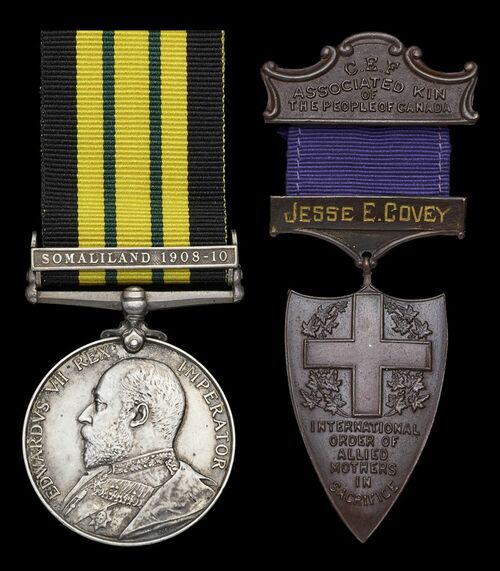
Auction: 24001 - Orders, Decorations and Medals
Lot: 88
(x) An unusual pair awarded to Stoker Class I J. E. Covey, Royal Navy, a Canadian killed aboard the Hampshire, whose mother was presented with the International Order of Allied Mothers in Sacrifice
Africa General Service 1902-56, 1 clasp, Somaliland 1908-10 (308428 J. E. Covey, Sto. 1Cl. H.M.S. Proserpine.); International Order of Allied Mothers in Sacrifice, bronze medal, named on the reverse to 'Jane Covey', additionally inscribed on the obverse 'Jesse E. Covey', good very fine (2)
Jesse Edmund Covey was born at Milford on 16 October 1886 and worked as a brickmaker prior to enlisting with the Royal Navy on 8 May 1905 as Stoker Class II. Advanced Stoker with Grafton on 1 July 1906 he was still serving in this role when he was posted to Proserpine in September.
She was at that stage on the East Indies Station and spent much of her time hunting pirates, slavers and gun runners off East Africa. It was for this that her crew received the Somaliland Clasp, as their efforts harmed the flow of weapons to the tribes supporting the Mullah's forces in Somaliland. Leaving Proserpine he served on a variety of postings before being stationed with Hampshire in January 1914, he was to serve with her throughout the Great War.
This vessel was stationed at Wei Hai Wei on the outbreak of the Great War and conducted operations against German territories here. Taking part in the hunt for the commerce raider Emden in 1914 Hampshire was finally posted back to Britain and joined the 7th Cruiser Squadron with the Grand Fleet.
Joining 2nd Cruiser Squadron she was still with this unit which formed part of the cruiser screen for Admiral Jellicoe's battleships. Hampshire took the role of linking ship between the screen and Jellicoe's Flagship Iron Duke. In that role she fired several salvoes at the 2nd Scouting Group but found herself to be out of range. She managed to avoid taking a hit throughout the battle.
With the fighting done the Grand Fleet returned to its station at Scapa Flow and Hampshire was detailed for a special mission. Lord Kitchener himself was travelling to Russia in order to meet with the Government and discuss munition shortages and military strategy. She sailed only to encounter heavy seas, her destroyer escort was lost and she was isolated. Reaching the Marwick Head, about a mile and half off the mainland of Orkney, Hampshire struck a mine laid by U-75. What followed is summarised on the 'Scottish Wreck' website:
'It was around 8.30 p.m. Suddenly the ship was rocked by a loud explosion and almost immediately she was plunged into total darkness as all electrical power failed. Survivors later described the acrid smell of fumes from the exploding mine which permeated the sinking ship as the crew scrambled through the darkness in an attempt to save themselves. The terrifying roar of rushing water could be heard throughout most of the ship. The crew knew instantly that their ship was doomed and that their own chances of survival in the cold, angry seas off Orkney were slim. However, discipline was maintained as the crew rushed to their muster stations and waited the command to abandon ship. Some of the survivors recalled seeing Kitchener on deck before she went down but he and his staff were to perish that night along with the vast majority of the ship's crew of more than six hundred.
The mine had struck on the port side at the forward engine room and had ripped a huge hole in the bottom of the ship. With water quickly filling this huge space the building pressure rapidly smashed the engine room bulkhead and the Hampshire was doomed. The devastation in the engine room itself was appalling with most of the crew in the area killed instantly by the explosion. Elsewhere on the ship the crew flooded the magazine to avoid further explosions while they desperately tried to reach the comparative safety of the deck. However, once on deck the situation was little better. The larger lifeboats could not be launched as they were lowered by electrically powered winches and all power had been lost. A few smaller boats were launched but were immediately smashed against the side of the ship or overturned in the heavy swell throwing their occupants into the boiling sea. The most effective rescue devices were the huge cork Carley floats which were simply hurled into the sea. Many survivors clambered aboard these simple structures. The few seamen who reached the safety of the Carley floats looked back in awe as the huge ship reared her stern high in the air and sank by the bow.
Ashore on Orkney a few islanders actually witnessed the explosion and watched in horror as the huge ship plunged to the seabed. The alarm was raised and a message sent to Stromness. Later, there was considerable controversy over the apparent delays in the rescue efforts. The lifeboat at Stromness was not called out though it must be questionable if it could have reached the area in the dreadful sea conditions that night. In the end it was 9.45 p.m. before the ocean-going tug Flying Kestrel and the trawlers Northward and Renzo put to sea. Over the next few hours many other ships were sent to the scene but it was too late. These ships did not pick up a single survivor.'
Covey was serving as a Leading Stoker by the time of the sinking and would likely have been below the water line when the impact occurred. If he was not killed instantly he perished when the cruiser sank into the freezing water of the North Sea. His body was one of the few recovered after the tragedy and buried at Lyness Royal Naval Cemetery. His mother received the International Order of Allied Mothers in Sacrifice, an award sent to grieving mothers by an Ontario based organisation, The Associated Kin of the Canadian Expeditionary Force; sold together with copied service papers, census data, medal roll and Commonwealth War Graves certificate.
Subject to 5% tax on Hammer Price in addition to 20% VAT on Buyer’s Premium.
Sold for
£350
Starting price
£180




